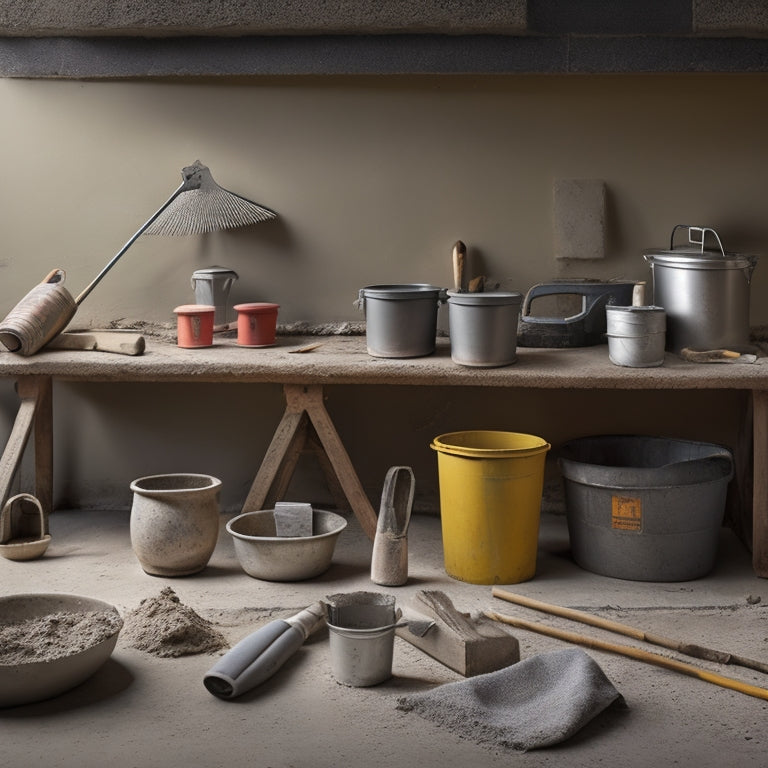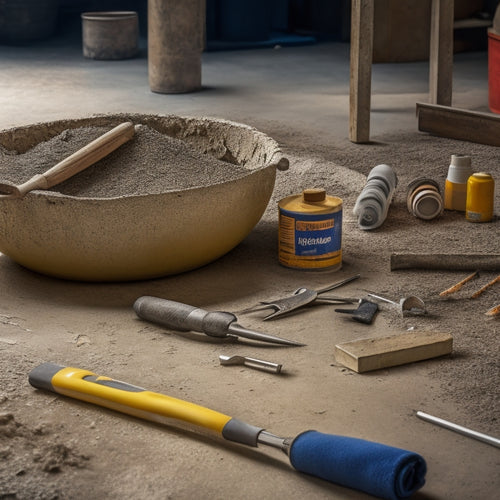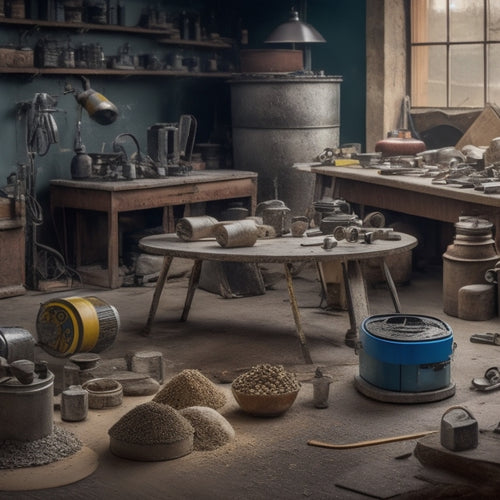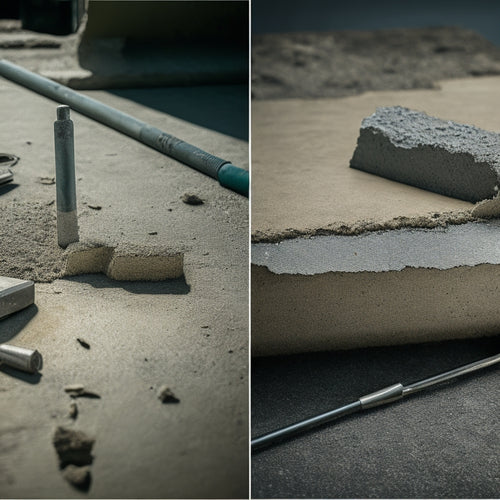
Top Tools for Concrete Plastering Projects
Share
When tackling concrete plastering projects, you'll need a range of specialized tools to achieve professional results. Essential hand tools include trowels, putty knives, and hawks for applying and smoothing plaster. Power tools like walk-behind power trowels and concrete grinders help with large areas and imperfections. Measuring and testing equipment, such as levels, moisture testers, and pH testers, guarantee accurate surface preparation. Additionally, mixing and applying tools, like mixing drums and trowels, are critical for achieving the right consistency. By investing in these top tools, you'll be well on your way to a successful project - and uncovering the finer details that set pros apart.
Key Takeaways
- A trowel is essential for smoothing and applying plaster, while a putty knife is useful for scraping and applying plaster in tight spaces.
- A walk-behind power trowel and concrete grinder/polisher are necessary for smoothing and polishing concrete surfaces.
- Measuring and testing equipment, including level and alignment tools, moisture testers, and pH testers, ensure optimal plastering conditions.
- Mixing and applying tools, such as mixing drums, mixing paddles, and hawks, are critical for achieving the perfect mix consistency and applying plaster efficiently.
- Finishing tools, including high-quality finishing trowels, putty knives, and floats, are necessary for achieving a smooth, even finish and removing excess plaster.
Essential Hand Tools for Plastering
Your trowel becomes an extension of your hand as you smooth out the freshly mixed plaster, but it's not the only essential tool in your arsenal.
You'll also need a putty knife for scraping and applying plaster to tight spaces, and a hawk for holding and carrying plaster as you work. A level guarantees your surface is straight and even, while a straightedge helps you achieve sharp, clean lines.
Don't forget a bucket or mixing tub for mixing and storing your plaster, and a sponge or trowel dampener for keeping your tools clean and moist.
When it comes to surface preparation, a wire brush or scraper is essential for removing dirt, grime, and old adhesives from the surface.
A scratch awl helps you create a key for the plaster to bond to, and a joint tape measure guarantees accurate measurements for your plastering techniques.
With these hand tools in your toolkit, you'll be well-equipped to tackle any plastering project that comes your way.
Power Tools for Smoothing Concrete
Precision is key when it comes to smoothing concrete, and that's where power tools come into play. You'll need the right equipment to achieve a smooth, even finish, especially when working with different concrete types.
For surface preparation, a walk-behind power trowel is a must-have. This tool helps remove excess material, fills in gaps, and leaves a smooth surface for finishing.
When it comes to polishing, a concrete grinder or polisher is essential. These machines use rotating heads with abrasive pads or diamonds to remove imperfections and bring out the desired shine. You can choose from electric or gas-powered models, depending on the size of your project and your personal preference.
Remember to always follow the manufacturer's instructions and safety guidelines when operating power tools. With the right equipment and a bit of practice, you'll be smoothing concrete like a pro in no time.
Measuring and Testing Equipment
You'll need to ascertain accuracy and precision in your concrete plastering project, and that's where measuring and testing equipment come in.
You'll rely on level and alignment tools to guarantee a perfectly flat surface, while moisture and pH testers will help you determine the ideal conditions for application.
Additionally, edging and joint gauges will allow you to achieve precise joints and edges that meet specifications.
Level and Alignment Tools
To achieve a high-quality concrete plastering job, guaranteeing accurate levels and alignment is essential. You can't just eyeball it; you need the right tools to get it spot on. That's where level and alignment tools come in. These tools help you master leveling techniques and alignment methods, guaranteeing your concrete plastering project is straight, even, and plumb.
You'll need a laser level to project a level line or plane across your work surface. This is especially useful for large areas or when working with multiple teams. A spirit level, on the other hand, is perfect for smaller areas and quick checks.
Don't forget a precision alignment tool, like a straightedge or string line, to guarantee your lines are straight and true.
When choosing level and alignment tools, look for accuracy, durability, and ease of use. You don't want to be fiddling with finicky tools when you've got a job to finish.
With the right tools, you'll be able to achieve professional-looking results and avoid costly rework. So, invest in high-quality level and alignment tools, and take your concrete plastering skills to the next level.
Moisture and Ph Testers
As concrete plastering projects progress, it's vital to monitor the substrate's moisture levels and pH to guarantee a successful bond between the plaster and the surface. You can't just slap on some plaster and hope for the best – that's a recipe for disaster.
Moisture control is fundamental, and that's where moisture testers come in. These handheld devices measure the moisture content of the substrate, ensuring it's within the ideal range for plastering.
pH testers are equally important, as they determine the substrate's acidity or alkalinity. Why does this matter? Because plaster won't adhere properly to surfaces with extreme pH levels. By testing the pH, you can adjust the surface preparation accordingly, ensuring a strong bond between the plaster and the surface.
Investing in reliable moisture and pH testers is a no-brainer. These tools provide accurate readings, helping you identify potential issues before they become major problems.
Don't risk a failed plastering project – get the right tools for the job. With moisture and pH testers, you'll be well on your way to a successful, long-lasting finish.
Edging and Joint Gauges
Accurate edging and joint formation are essential aspects of concrete plastering, and that's where edging and joint gauges come into play.
You can't just wing it when it comes to creating smooth, even joints and edges - you need the right tools to guarantee precision and quality.
Edging and joint gauges are designed to help you achieve professional-looking results by providing a precise measurement of your edging techniques and joint sealing.
Here are some key features to look for in your edging and joint gauges:
- Adjustable depth settings to accommodate different joint widths and edging techniques.
- High-contrast markings for easy readability, even in low-light conditions.
- Durable construction to withstand the rigors of daily use on the job site.
- Ergonomic design for comfortable grip and reduced fatigue.
Safety Gear for Plasterers
Within the confines of a plastering job site, you're surrounded by potential hazards, from airborne particulates to heavy equipment, which makes wearing the right safety gear vital to preventing injuries and illnesses. As a plasterer, you know that personal protective equipment (PPE) isn't just a nice-to-have, but a must-have.
Your employer might provide some gear, but it's important to invest in your own PPE to guarantee a proper fit and best protection.
Injury prevention starts with a good hard hat, safety glasses, and a dust mask. Don't underestimate the significance of gloves – they'll save your hands from abrasions, cuts, and chemical exposure. Steel-toed boots are a no-brainer, given the heavy materials and equipment you'll be working with.
Don't forget earplugs and a first-aid kit, either. Remember, safety gear isn't a one-size-fits-all solution. Take the time to select gear that fits comfortably and provides adequate protection for your unique needs.
Mixing and Applying Tools
Your mixing and applying tools are the workhorses of your plastering operation, responsible for transforming raw materials into a smooth, even finish.
These tools are vital in determining the quality of your final product, so it's important to have the right ones for the job.
-
Mixing Drums: You'll need a sturdy, reliable mixing drum to combine your cement, sand, and water. Look for one with a durable construction and a comfortable handle to make mixing easier.
-
Mixing Paddles: A good mixing paddle is a game-changer for achieving the perfect mix. Choose one with a sturdy shaft and a paddle that's the right size for your mixing drum.
-
Hawk or Mud Pan: A hawk or mud pan is important for holding and transporting your mixed plaster. Opt for one with a comfortable handle and a smooth, even surface to prevent sticking.
- Trowels: Your trowel is the most critical tool for applying plaster. Select one that feels comfortable in your hand, with a balanced weight and a smooth, even blade to achieve a flawless finish.
Mastering your mixing techniques and application methods will take your plastering skills to the next level.
With these important tools, you'll be well on your way to creating stunning, professional-looking results.
Finishing and Smoothing Tools
As you move on to the finishing stages of your plastering project, you'll rely on a specific set of tools to transform your applied plaster into a smooth, polished surface.
Finishing and smoothing tools are vital in achieving a professional-looking finish, and it's important to have the right ones in your arsenal.
A high-quality finishing trowel is your go-to tool for this stage. With the right trowel techniques, you can achieve a smooth, even surface. Look for a trowel with a flexible blade and a comfortable grip to make the process less strenuous.
For surface preparation, a putty knife or a scraping tool is perfect for removing excess plaster and creating a smooth surface for finishing.
A float is another important tool for smoothing out the plaster. Its flat, broad surface helps to spread and level the plaster, eliminating any imperfections. A Darby or a rubber float is ideal for this purpose.
Finally, a clean, lint-free cloth or sponge is necessary for wiping away excess water and applying a finish coat.
With these finishing and smoothing tools, you'll be well on your way to achieving a professional-looking finish that'll make your plastering project stand out.
Frequently Asked Questions
Can I Use a Regular Drill for Mixing Small Batches of Concrete?
You can try using a regular drill for mixing small batches of concrete, but don't expect it to be a smooth ride; opt for a heavy-duty drill or a dedicated mixer for efficient mixing techniques and to avoid drill burnout.
How Often Should I Clean and Maintain My Plastering Tools?
You should clean your plastering tools daily, and dedicate a few hours weekly to deep cleaning and maintenance, storing them properly in a dry place to prevent rust and extend their lifespan, you clever DIYer!
Are There Any Eco-Friendly Alternatives to Traditional Plastering Materials?
You're on a mission to go green! Look for eco-friendly alternatives that swap traditional plastering materials for natural binders like lime or clay, paired with sustainable aggregates like recycled glass or fly ash, reducing your project's carbon footprint.
Can I Reuse Old or Leftover Concrete for Small Repairs?
You're wondering if you can reuse old or leftover concrete for small repairs? Yes, you can! Recycling concrete offers benefits like reduced waste and lower costs; plus, you can repurpose leftover concrete for sub-base materials, aggregate, or even decorative features like planters or pathways.
What Is the Ideal Temperature for Applying Concrete Plaster?
You'll be surprised to know that 75% of concrete failures are due to temperature-related issues! When applying concrete plaster, you'll want to guarantee ideal conditions, as temperature impact is essential - aim for a range of 50°F to 70°F (10°C to 21°C) for best results.
Conclusion
You've made it through the gauntlet of concrete plastering tools, and now you're probably thinking, "I'm a pro, I can conquer any project!" Not so fast. Remember, having the right tools is only half the battle. It's the skill and expertise that separates the masters from the mess-makers. So, don't get too cocky, and always keep practicing. With these top tools and a healthy dose of humility, you'll be well on your way to creating concrete masterpieces that'll make the pros proud.
Related Posts
-

Top Tools for Repairing Cracked Concrete Surfaces
When tackling a cracked concrete surface repair, you'll need the right tools to guarantee a durable fix. Start with e...
-

Top DIY Concrete Grinding and Polishing Tools
When selecting DIY concrete grinding and polishing tools, you'll want to take into account a range of factors to guar...
-

Top Tools for Concrete Adhesion Success
When it comes to concrete adhesion success, you'll need to wield the right tools and techniques to guarantee a strong...


